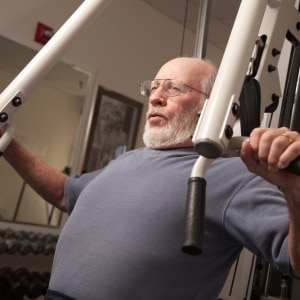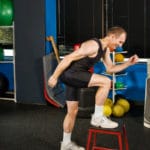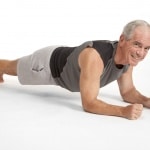January 2019
Within-Session Muscle Confusion Helps Older Adults
Muscle confusion – the concept of doing pretty high intensity exercises in rapid sequence varying body parts and muscle groups – is a 21st century marketing pitch. Periodization – the idea that a training program should be divided into various elements on daily, weekly or monthly basis aiming at a specific component of fitness or strength – has been around for over 30 years. Both concepts have been shown to be useful for improving strength, power, speed and function in younger, athletic populations. But how about for my friends over 60? Read more here, here and here.

Both periodization models yielded “similarly significant dynamic strength increases” as well as similar benefits in functional tasks such as The Get-Up-and-Go and climbing and descending stairs, in addition to increased fat free mass of the lower extremities – that is, more muscle mass in the legs. Compared to the control group, both the TP and the MP proved valuable on all the metrics but were not that different from each other.
While the sample sizes were small for all groups, the effect sizes for some of the strength measures was greater for the MP group than the TP. Obviously further study is necessary to say with certainty which is better but it’s clear both models help older adults.
JSCR Oct. 2018
Shin Splints Linked to Strength and Biomechanical Flaws
Medial tibial stress syndrome (MTSS), a fancy name for shin splints, are the bane of many runners’ existence. A common overuse injury, many studies have attempted to determine what precursors other than doing too much too soon contribute to it. Some Western researchers studies 24 Division I cross country runners prospectively to figure out what strength, flexibility or biomechanical conditions could cause an accomplished runner to get MTSS.
All runners were tested for strength and passive flexibility of the quadriceps, hamstrings, iliotibial band/tensor fascia lata (ITB/TFL), hip flexors, hip rotators and ankle flexors and extensors, as well as running mechanics.
Contrary to their hypothesis that greater hip internal rotation and adduction during running was not different between those who developed MTSS and those who didn’t. Nonetheless, they did find that those who got MTSS did have weaker hip abductors (gluteus medius), tighter ITBs, and longer durations and higher peak rearfoot (heel) eversion (pronation) during stance than those who didn’t. Furthermore, they also had higher peak contralateral (other side) pelvic drop during stance, an indicator of both weaker gluteus medius and greater foot pronation. In further analysis, it was found that the duration of eversion/pronation was a stronger predictor of injury than the range of pronation.
The authors conclude that an MTSS injury is multifactorial, where strength of hip muscles and gait mechanics need to be measured and corrected to minimize risk to distance runners.
MSSE Oct. 2018
Tid Bits
A multi-center study supported the well-known correlation between hand-grip strength and mortality in older adults. For every 5 kg decrease in strength, there’s a 20% decrease in ability to feed oneself, 14% decrease for walking and bathing, 9% decrease for dressing, 8% decrease for transferring and 6% decrease for toileting. In other words, you become less able to self-care. MSSE Nov. 2018
Typical hemodynamic responses after exercise vary between lean and obese men, a study from Arizona showed. Blood pressures, stroke volume, cardiac output, vascular resistance are altered during and after exercise. (Long-term training also causes beneficial changes in these.) Over a 2-week, 3/wk cardio training routine, they found that post-exercise systolic pressures (post-exercise hypotension) dropped in lean, which is a favorable response, but rose in obese subjects. Lean subjects had more consistent results compared to obese subjects. MSSE Nov. 2018
Intermittent dieting (ID), or intermittent fasting – two sides of the same coin for weight loss – is the vogue dietary model. Based on the common principle of reducing caloric intake, ID limits the hours of the day during which you can eat…but not binge to compensate. Generally it’s a 16:8 ratio of not eating to eating. A recent article in the International Journal of Obesity reported that ID done on a bi-weekly basis of 8 cycles of 2 weeks of low calorie/2 weeks of weight-maintenance calorie intake vs another group doing calorie restriction for 16 weeks straight helped the ID group lose 47-80% more weight without experiencing reduced metabolic rates. The ID group was better able to sustain the program of alternating calorie restriction weeks. Duke Health News Jan. 2019
















